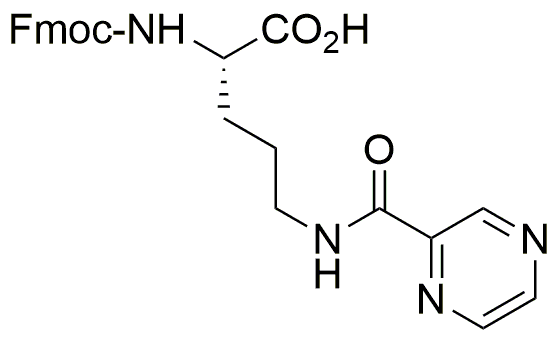Na-Fmoc-Nd-pyrazinylcarbonyl-L-ornithine is widely utilized in research focused on
- Peptide Synthesis: This compound serves as a protective group in the synthesis of peptides, allowing for the selective modification of amino acids. Its stability under various conditions makes it a preferred choice for researchers in the field of biochemistry.
- Drug Development: In pharmaceutical research, it is used to develop novel therapeutic agents, particularly in the design of peptide-based drugs. Its unique structure can enhance the bioactivity of compounds, making it valuable in medicinal chemistry.
- Bioconjugation: The compound is employed in bioconjugation techniques, where it helps attach biomolecules to surfaces or other molecules. This is particularly useful in creating targeted drug delivery systems in cancer therapy.
- Protein Engineering: Researchers utilize it in protein engineering to modify proteins for improved stability and functionality. This application is crucial in biotechnology and enzyme design.
- Analytical Chemistry: It is also used in analytical methods to study interactions between biomolecules, aiding in the understanding of complex biological systems and pathways.
Información general
Propiedades
Seguridad y normativas
Aplicaciones
Na-Fmoc-Nd-pyrazinylcarbonyl-L-ornithine is widely utilized in research focused on
- Peptide Synthesis: This compound serves as a protective group in the synthesis of peptides, allowing for the selective modification of amino acids. Its stability under various conditions makes it a preferred choice for researchers in the field of biochemistry.
- Drug Development: In pharmaceutical research, it is used to develop novel therapeutic agents, particularly in the design of peptide-based drugs. Its unique structure can enhance the bioactivity of compounds, making it valuable in medicinal chemistry.
- Bioconjugation: The compound is employed in bioconjugation techniques, where it helps attach biomolecules to surfaces or other molecules. This is particularly useful in creating targeted drug delivery systems in cancer therapy.
- Protein Engineering: Researchers utilize it in protein engineering to modify proteins for improved stability and functionality. This application is crucial in biotechnology and enzyme design.
- Analytical Chemistry: It is also used in analytical methods to study interactions between biomolecules, aiding in the understanding of complex biological systems and pathways.
Documentos
Hojas de datos de seguridad (HDS)
La SDS proporciona información de seguridad completa sobre la manipulación, el almacenamiento y la eliminación del producto.
Especificación del producto (PS)
La PS proporciona un desglose completo de las propiedades del producto, incluida la composición química, el estado físico, la pureza y los requisitos de almacenamiento. También detalla los rangos de calidad aceptables y las aplicaciones previstas del producto.
Certificados de análisis (COA)
Busque certificados de análisis (COA) ingresando el número de lote del producto. Los números de lote y de partida se pueden encontrar en la etiqueta de un producto después de las palabras "Lote" o "Lote".
Número de catálogo
Número de lote/lote
Certificados de origen (COO)
Este certificado de origen confirma el país en el que se fabricó el producto y también detalla los materiales y componentes utilizados en él y si se deriva de fuentes naturales, sintéticas u otras fuentes específicas. Este certificado puede ser necesario para cumplir con las normativas aduaneras, comerciales y regulatorias.
Número de catálogo
Número de lote/lote
Hojas de datos de seguridad (HDS)
La SDS proporciona información de seguridad completa sobre la manipulación, el almacenamiento y la eliminación del producto.
DownloadEspecificación del producto (PS)
La PS proporciona un desglose completo de las propiedades del producto, incluida la composición química, el estado físico, la pureza y los requisitos de almacenamiento. También detalla los rangos de calidad aceptables y las aplicaciones previstas del producto.
DownloadCertificados de análisis (COA)
Busque certificados de análisis (COA) ingresando el número de lote del producto. Los números de lote y de partida se pueden encontrar en la etiqueta de un producto después de las palabras "Lote" o "Lote".
Número de catálogo
Número de lote/lote
Certificados de origen (COO)
Este certificado de origen confirma el país en el que se fabricó el producto y también detalla los materiales y componentes utilizados en él y si se deriva de fuentes naturales, sintéticas u otras fuentes específicas. Este certificado puede ser necesario para cumplir con las normativas aduaneras, comerciales y regulatorias.


